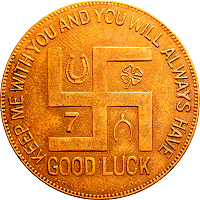|
|
|

Hitler and the rest of them didn't get into their politics of hate until 1920 or 1921, so whoever made the chip would have been unlikely to have known of the twisted new meaning. Lets be fair?
The equilateral cross with legs bent at right angles – that looks like swirling arms or a pattern of L shapes – has been a holy symbol in Hinduism, Jainism and Buddhism for centuries.
The Navajos, Tibetans and Turks incorporated the swastika into their rugs. Arizona's indigenous Pima and Maricopa people wove them into their baskets and painted them onto their pots.
The swastika is derived from Sanskrit word “Swasti” meaning may all be well with you.
In Chinese and Japanese art, the swastika is often found as part of a repeating pattern.
By the early 20th century, it was used worldwide and was regarded as a symbol of good luck and success.

The Swastika has lost it's historic, ancient meaning and religious significance, because of one evil dictator and the political party in power, using the same symbol. But that doesn't mean the origins and history have somehow become something they never were.

|
|